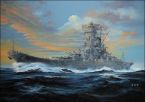Lrfss
Posts: 349
Joined: 5/20/2002
From: Spring, TX
Status: offline

|
quote:
ORIGINAL: usersatch
quote:
ORIGINAL: John Lansford
usersatch,
By that analogy, a human swinging a standard hammer should eventually be able to break through a BB's belt armor if he just keeps at it long enough. Armor belts don't work like that though; either the shell had enough kinetic energy to smash through the armor or it doesn't; if it lacks enough energy, then the armor resists the shell and is not affected. Body armor isn't a good comparison because it absorbs the bullet's energy by deforming rather than outright resisting the force.
Think of a BB's armor as like the standard concrete "jersey barriers" you see in highway medians. If a car strikes one it is deflected and the concrete suffers no damage. A big enough truck may smash through it if it travels fast enough, though. A 6" shell hitting a BB's armor is similar to a compact car hitting a concrete barrier; all the energy is used in smashing the shell, not the armor plate, just as the car is smashed hitting the concrete.
You just proved my point! Body armor reacts by dissipating the force of the relatively flat-faced projectile to a wide surrounding area. Hard, frontal armor reacts to, presumably, a naval AP round, by dissipating the kinetic energy of the projectile at a very small point around, but mostly behind the point of impact. The AP round has a very small surface area of impact as compared to a normal HE round, but with the same amount of kinetic energy. The frontal armor relies on its thickness rather than its surface area (like body armor) to defat the round, or dissipate the energy. Hit body armor with AP bullets or an arrow, they will go clean through. Armor plating doesnt "resist" incoming projectiles at all--it absorbs the energy (KE = 1/2mv^2) where some is lost as heat, friction, etc. upon impact, but most of the energy is transferred directly from the projectile to the object of impact and directly behind it. But, each time it absorbs (or resists) a huge force at that small point, it weakens the material in a very small area.
Using your analogy of auto concrete barriers, yes, a compact car (or even a semi for that matter) doesnt have a lot of kinetic energy per square inch versus the total surface area of the front of the vehicle, but if you focus all of that kinetic energy down to a very small cross section of just a few inches, there's a hell of a lot of energy waiting to be transferred. If the car glances, or is deflected, off the barrier (some energy going in the x-plane but most going in the y-plane), significantly less energy is transferred than if it hits it at a 90 degree angle with no deflection, (all energy going in the x-plane). This is why modern tanks have sloped frontal armor. Like I said, I'm not a materials engineer, but I am a physicist, so I do know that each hit (if powerful enough) can break a few of the lattice bonds in the concrete (or steel). Concrete (and steel) are arranged in interconnected "sheets" of atoms, or a lattice. When a force hits the lattice, it is dissipated to the surrounding atoms. But, hit it enough and the atomic bonds in the outermost sheets begin to break and give way. It may take 2 semis or 2000 sedans to do it, but one way or the other, the material (and the bonds that hold it together) can absorb only so much before it fails. What I don't know is exactly what a single sedan does to a concrete barrier crashing head on on a micro level (or an AP round striking a nearly perpendicular sheet of BB armor).
I'm in no way saying that a single 6 inch AP round will penetrate BB belt armor, but if you fire enough of them at the approximately same point of impact, eventually they will. IRL, I would take it to Vegas (betting against it, of course) with the chances of that many rounds hitting in the same spot.
Hi All:
I'm going with the Physicist "usersatch" on this one... However it is absurd unless the BB's were anchored that any where near 150 6" rounds could have even struck within the same reasonable proximity on a "I hope" moving/manuvering BB in the first place let alone to cause it to sink! How long would it even take to fire that many rounds off assuming trying to be accurate no doubt? Sorry I forget how many tubes though were firing, but still come on... However it is absurd unless the BB's were anchored that any where near 150 6" rounds could have even struck within the same reasonable proximity on a "I hope" moving/manuvering BB in the first place let alone to cause it to sink! How long would it even take to fire that many rounds off assuming trying to be accurate no doubt? Sorry I forget how many tubes though were firing, but still come on...
The idea of a routine enabling withdrawing prior to a "Total Loss" situation sounds to me like a good plan except wherein one foolishly takes his BB's, CA's in with the landing craft or more mildy put includes BB's, CA's or the like within an Amphib TF in a landing op. In that situation oh well? The odds go up like crazy for critical hits and well placed rounds to do major if not catastrophic damage based on obvious close range/greater penetration/better accuracy factors, etc. I think that the game models the BB's, CA's etc as sitting still as opposed to moving/manuvering as how else could you explain the results the OP experienced here? Just my $.02 (U.S.) here...
_____________________________
|
 Printable Version
Printable Version










 However it is absurd unless the BB's were anchored that any where near 150 6" rounds could have even struck within the same reasonable proximity on a "I hope" moving/manuvering BB in the first place let alone to cause it to sink! How long would it even take to fire that many rounds off assuming trying to be accurate no doubt? Sorry I forget how many tubes though were firing, but still come on...
However it is absurd unless the BB's were anchored that any where near 150 6" rounds could have even struck within the same reasonable proximity on a "I hope" moving/manuvering BB in the first place let alone to cause it to sink! How long would it even take to fire that many rounds off assuming trying to be accurate no doubt? Sorry I forget how many tubes though were firing, but still come on... 




 New Messages
New Messages No New Messages
No New Messages Hot Topic w/ New Messages
Hot Topic w/ New Messages Hot Topic w/o New Messages
Hot Topic w/o New Messages Locked w/ New Messages
Locked w/ New Messages Locked w/o New Messages
Locked w/o New Messages Post New Thread
Post New Thread